Your Electric Bill After Going Solar: How It Works
Solar panels probably won't erase your bill, but they can still save money. How much depends on several factors.

Some or all of the mortgage lenders featured on our site are advertising partners of NerdWallet, but this does not influence our evaluations, lender star ratings or the order in which lenders are listed on the page. Our opinions are our own. Here is a list of our partners.
You will probably still have an electric utility bill after going solar. Most homeowners need power from the grid at night and when their panels aren’t producing enough electricity. The average monthly residential electric bill is $136.84 for 855 kilowatt hours, according to the Department of Energy .
However, solar panels should reduce electricity bills; in some cases, your bill may go to zero.
How does billing work when you have solar?
The size of your electric bill after installing solar panels depends on your specific situation. Every state has its own regulations, utilities offer different rates and options, and each home is unique. The average price of electricity per kilowatt hour for the West Coast, New England and the Mid-Atlantic regions tends to be above the national average, but cheaper than the national average in the South and Rocky Mountain regions .
For example, here’s my electric bill for May 2024 as a solar customer in California’s Pacific Gas and Electric Co. (PG&E) service territory.
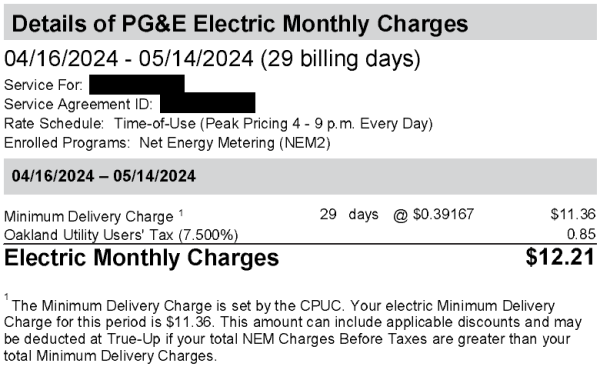
How much will I save on my electric bill with solar?
How much you will save on your electric bill with solar depends on seven key factors:
- Whether your solar system is sized to cover all of your electricity consumption.
- How many hours of sunlight your home gets.
- How much your solar panels cost.
- Whether you leased your solar system, got a loan or paid cash for it.
- Your utility’s electricity rates and rate structures.
- Whether your utility offers net metering or net billing.
- Your utility’s net metering or net billing export rate.
Do solar panels really reduce electricity bills?
Electric bills can be challenging to navigate, and there’s no one-size-fits-all example. But by familiarizing yourself with these key concepts, you’ll be able to understand what your electric bill could look like after getting solar:
- Net metering and net billing.
- True-up statements.
- Fixed charges.
- Nonbypassable charges.
- Types of utility rate plans.
» MORE: How to spot solar scams
Net metering and net billing
Net metering is a billing mechanism in which the utility company credits your electric bill, usually at the retail rate, for excess solar electricity you generate and send to the power grid.
- Although net metering is available in many areas, not all states or utilities offer it.
- Some states, such as California and Arizona, have been transitioning away from net metering and toward something called net billing, in which the credits you get for sending power back to the grid are lower than the retail rate.
- How net metering shows up on your electric bill depends on your state and utility. You might get your statement credit monthly or annually.
Here’s an example of NEM charge details from my bill. The total is negative because my solar panels were producing a lot of energy during that period, so I was sending more electricity to the grid than I was pulling from the grid. In the winter months, the situation is reversed. Short, cloudy days mean my panels often don’t generate enough power, so I take more power than I give to the grid.
» MORE: Do solar panels work at night?
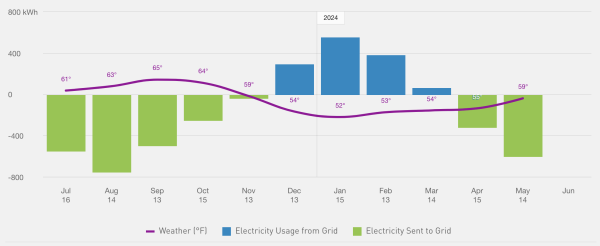
My utility company shows the monthly net metering balance for informational purposes only; it reconciles my account annually via a true-up statement.
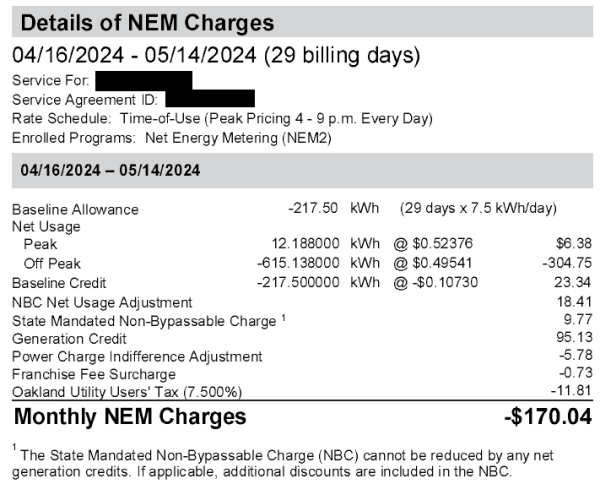
True-up statements
A true-up statement is a formal accounting of how much electricity you took from the grid and sent to the grid over a specific period of time. If the utility company reconciles net metering credits annually, you’ll get a true-up statement once a year. If the amount of electricity you used from the grid over the year was greater than the amount you sent to the grid, the true-up bill is what your utility will charge you for that balance. If you produced more energy than you used, this is when you may be compensated for the excess amount, depending on your state and utility .
For my home, that’s expected to be a bit under $20 for 2024. On my NEM summary, you can see the mention of a true-up statement:
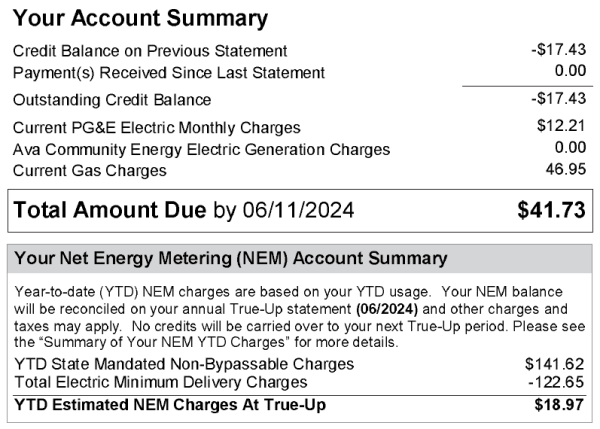
You can avoid having to pay anything at your annual true-up by sizing your solar system to cover all your electricity needs.
Fixed charges
In many states, utility companies make all customers pay fixed charges for electricity. Typically, these are to maintain the power grid for everyone, including solar customers. Fixed charges may be listed on your bill in many ways, such as service charges or customer service fees.
If your utility company has fixed charges, the only way to get your electric bill to zero is to offset those charges by producing more solar energy than you use. That can be tough to do if the utility company pays little to buy that excess electricity from you. For example, under NEM 3.0 in California, the export rate for solar energy sent back to the grid is so low that it’s not worth trying to compensate for fixed charges by producing excess solar.
Nonbypassable charges
Some states mandate nonbypassable charges, or NBCs, for all utility customers; you can see them on my bill above. As the name suggests, you can’t avoid these charges, even if you have solar. Depending on the state and utility, nonbypassable charges may pay for programs such as energy-efficiency programs, assistance for low-income customers, storm recovery or environmental programs , . States implement nonbypassable charges in different ways.
Types of utility rate plans
Utilities charge different types of rates; the following are the most common.
Fixed rates
Under this type of plan, you pay a fixed amount per kilowatt-hour (kWh) of electricity you pull from the grid, meaning the price is the same regardless of the day or time of day. Your bill depends on how much electricity you pull from the grid, but the rate per kWh stays the same.
Variable rates
Under this type of plan, what you pay per kWh fluctuates depending on supply and demand conditions. Accordingly, if power demand is low, you’ll pay less for the electricity you pull from the grid; if demand is high and supply is low, you’ll pay more.
Time-of-use (TOU) rates
Under TOU plans, the utility charges a price that more closely corresponds to what the utility must pay to generate or buy that power. For example, on a hot summer day when many people are relying on air conditioning, demand on the grid increases and so supply must also increase, which increases the utility’s cost to generate electricity. This is especially true in the early evening hours when people come home from work. TOU rates can shift according to the time of day and the season .
On my electric bill, you can see that I paid more per kWh for electricity during peak hours than during off-peak hours. In PG&E’s service territory, as in many areas, solar customers are required to be on a TOU rate plan .

During off-peak hours in this billing period, my solar system was generating more electricity than I was pulling from the grid; that’s why there's a negative number on that “Off Peak” line. I could reduce my bill by avoiding using appliances like my washer and dryer during peak hours. On my TOU rate plan, peak pricing occurs between 4 p.m. and 9 p.m. every day — when my solar system isn’t generating much electricity.
Tiered rates
Under a tiered rate plan, also known as an inverted rate system, you pay one rate per kWh if your usage stays below a certain threshold; you pay a higher rate per kWh if your usage exceeds that threshold. Tiered rate plans, used in some states, are intended to encourage customers to use less electricity. Because you’ll pull less electricity from the grid with solar, you’re less likely to go into a higher tier. This is one way that solar can help you save on your electric bill .
Demand charges
Some states impose demand charges on residential customers, and these charges are becoming more common. Demand charges are based on spikes in your energy demand. Your home could be using a relatively small amount of energy, but spikes during peak times can increase your electricity bill dramatically. This is because your utility has to keep enough power online to provide electricity for these spikes whenever they happen. Although a solar system can help lower demand charges by lowering your electricity use, it won’t help if your use spikes at a time when you’re not producing as much solar energy.
Can I get financing for a solar panel system?
In addition to tax incentives and rebates, there are options available. Many solar installers offer financing, but you may also be able to finance your solar investment through a home equity loan or home equity line of credit (HELOC). These options may have lower interest rates than financing with an installer, future opportunities for refinancing and possible tax benefits.
Home equity loans and HELOCs are ways to borrow against the value of your home, converting equity into cash. With a home equity loan, you receive a lump-sum payment and then pay it back at a fixed interest rate over an agreed period of time, typically from five to 30 years. HELOCs are more akin to a credit card, something you use as needed. You’ll usually have 10 years to draw from the line of credit, during which time you only have to pay interest, and after that you pay both the principal and interest. HELOC interest rates typically are variable, meaning your monthly payment could rise or fall over time. And with each of these options, you're using your home as collateral.
Advertisement
Min. credit score 600 | Min. credit score 600 |
Min. down payment N/A | Min. down payment N/A |
Another option is a solar loan. Many banks, credit unions and online lenders offer these to fund solar panels and installation, with amounts typically from $1,000 to $100,000, and annual percentage rates ranging from 6% to 36%. They function like a personal loan: you receive a lump sum and repay it in equal monthly installments over a set period, typically two to seven years. And unlike with home equity financing, there is no collateral required for a solar loan. This means your home or solar panels aren’t at risk if you miss payments, but you may have to pay late fees.
So, yes, you likely can get financing. If you go this route, compare interest rates, terms and fees with any financing package that a solar provider may offer you to ensure you get the best deal.
Frequently Asked Questions
What is a kWh?
The abbreviation kWh stands for kilowatt-hours, which is how your home’s electricity use is measured on your bill. A kWh represents the amount of electricity used over an hour. Using a 1,000-watt appliance for one hour takes 1 kWh of electricity while using a 60-watt light bulb for an hour takes 0.06 kWh.
Can I save even more with a home solar battery?
A home solar battery stores your solar power for later use. This can lower your monthly electric bills significantly in several circumstances:
- If the export rate for solar in your area is low, you can store energy in your battery to use later instead of selling it back to the grid.
- If you’re in an area with time-of-use rates, a battery can help you avoid using energy from the grid at times when it’s more expensive.
- A battery can help you avoid demand charges, if you’re subject to those in your area.
However, batteries are expensive. They cost between $12,000 and $22,000 before the 30% federal tax credit .
Article sources
NerdWallet writers are subject matter authorities who use primary,
trustworthy sources to inform their work, including peer-reviewed
studies, government websites, academic research and interviews with
industry experts. All content is fact-checked for accuracy, timeliness
and relevance. You can learn more about NerdWallet's high
standards for journalism by reading our
editorial guidelines.
- 1. U.S. Energy Information Administration. 2023 Average Monthly Bill- Residential. Accessed Nov 27, 2024.
- 2. U.S. Energy Information Administration. Electric Power Monthly. Accessed Nov 27, 2024.
- 3. Pacific Gas and Electric Co. Solar bill: How solar billing works. Accessed Jul 2, 2024.
- 4. North Carolina Utilities Commission. Net Metering. Accessed Jul 2, 2024.
- 5. Dominion Energy. Understand My Bill. Accessed Jul 2, 2024.
- 6. Federal Energy Management Program. Evaluating Your Utility Rate Options. Accessed Jul 2, 2024.
- 7. Pacific Gas and Electric Co. Get answers about solar billing. Accessed Jul 2, 2024.
- 8. SmartGrid.gov. Recovery Act: Time Based Rate Programs. Accessed Jul 2, 2024.
More like this
Related articles
AD
Save On Solar Without the Middleman
Free Instant Quote
on Project Solar's website

AD

Save On Solar Without the Middleman
- $750 OFF install with NerdWallet;
- SolarCare™: top-tier warranty & 25-year production guarantee;
- No sales commissions mean premium equipment & tech at up to half the price.
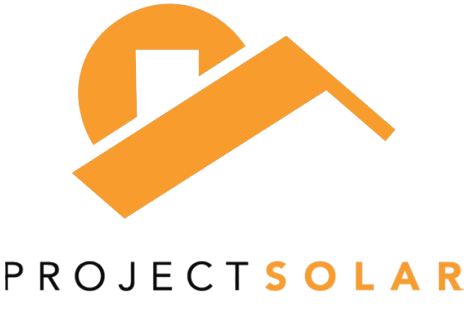
Free Instant Quote
on Project Solar's website











